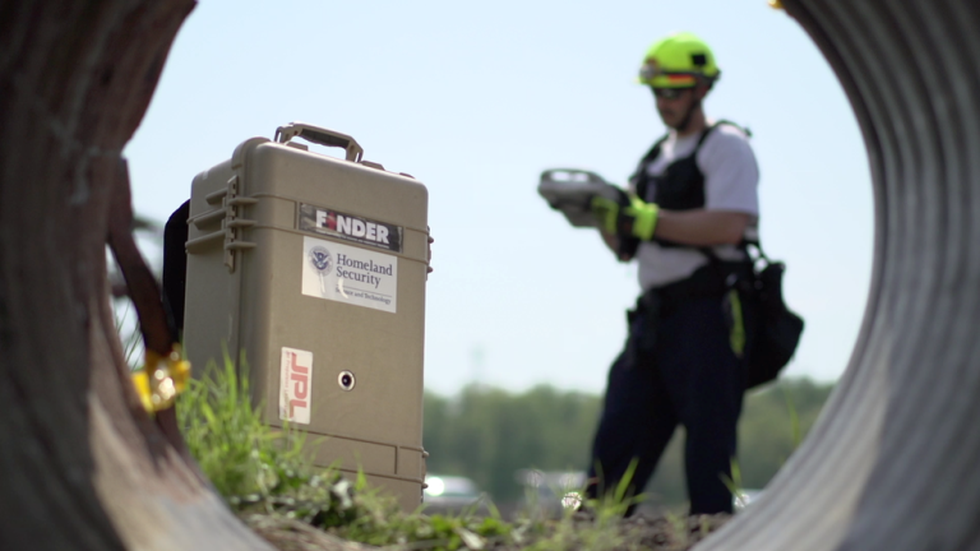
About FINDER device:
- The devices, called FINDERs( Finding Individuals for Disaster Emergency Response), use microwave radar sensors to find survivors underneath the rubble.
- It was designed to detect a human heartbeat buried beneath 30 feet of rubble.
- The radar illuminates the rubble pile and receives reflections back from a disaster site, including the victim.
- FINDER looks for changes in the reflection that indicate movement and then checks to see if those movements can be attributed to human heartbeats and respirations.
- It can distinguish human respiration from animals or mechanical movements.

About SURAJ Drones:
- It is a solar-powered, Intelligence, Surveillance, and Reconnaissance (ISR) high-altitude drone which can fly at an altitude of 3,000 ft.
- It is designed specifically for surveillance operations, providing real-time information to the high command, and protecting jawans on the ground.
- It will have ISR capability with Artificial Intelligence, machine learning and a bionic chip for advanced real-time processing.
- The drone would carry a payload of high-resolution zoom cameras with thermal imagery and foliage-penetrating lidar sensors with a maximum capacity of 10 kg.
- It is capable of capturing, processing, and transmitting photos and videos in real time.
- It is all set to support the Indian Army, Navy, Airforce, BSF, CRPF, CISF, ITBP, DRDO, MOD, and the Ministry of Home Affairs.
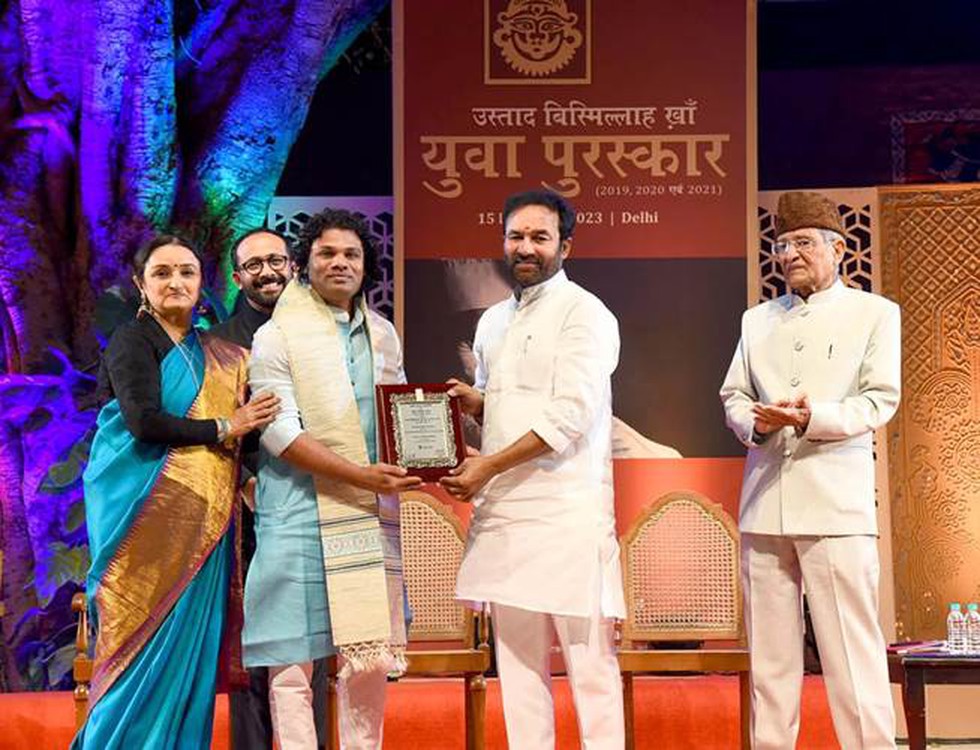
About Ustad Bismillah Khan Yuva puraskar:
- The Ustad Bismillah Khan Yuva Puraskar, given to artists up to the age of 40 years, was introduced in the year 2006.
- It is presented annually to artists who have demonstrated conspicuous talent in the fields of music, dance and drama.
- The award is presented by Sangeet Natak Akademi.
- It carries award money of Rs 25,000/- an Angavastram and a plaque.
- Nodal Ministry: Minister of Culture.
Who was Ustad Bismillah Khan?
- He was a famous Shehnai musician.
- It was Ustad ‘Bismillah” Khan who also played at the first Republic Day celebration in 1950.
- Bismillah Khan was the first Indian to be invited to perform at the prestigious Lincoln Centre Hall in the United States of America.
Key facts about the Sangeet Natak Akademi
- Sangeet Natak Akademi is India’s national academy of music, dance and drama.
- It was created by a resolution of the Ministry of Education, with Dr P.V. Rajamannar as its first Chairman.
- Presently it is an Autonomous Body of the Ministry of Culture and is fully funded by the Government for the implementation of its schemes and programmes.
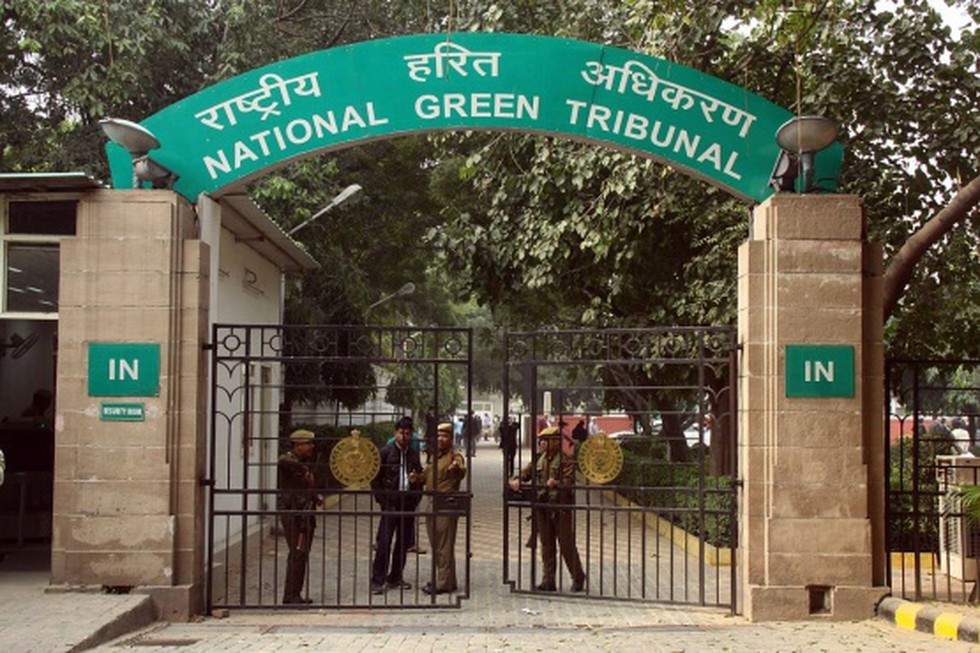
About National Green Tribunal:
- The National Green Tribunal has been established under the National Green Tribunal Act 2010.
- New Delhi is the Principal Place of Sitting of the Tribunal and Bhopal, Pune, Kolkata and Chennai shall be the other four places of sitting of the Tribunal.
- NGT is mandated to make disposal of applications or appeals finally within 6 months of the filing of the same.
What is the composition of NGT?
- The Tribunal comprises the Chairperson, the Judicial Members, and Expert Members.
- They shall hold office for a term of 5 years and are not eligible for reappointment.
- The Chairperson is appointed by the Central Government in consultation with the Chief Justice of India (CJI).
- A Selection Committee shall be formed by the central government to appoint the Judicial Members and Expert Members.
- There are to be at least 10 and a maximum of 20 full-time Judicial members and Expert Members in the tribunal.
Powers & Jurisdiction
- Established for effective and expeditious disposal of cases relating to environmental protection and conservation of forests and other natural resources.
- It has appellate jurisdiction to hear appeals as a Court.
- The Tribunal is not bound by the procedure laid down under the Code of Civil Procedure, 1908, but shall be guided by principles of natural justice.

About Yakshagana:
- Yakshagana is a traditional folk dance form popular in Coastal Karnataka
- It is a rare combination of dance, music, song, scholarly dialogues and colourful costumes.
- Traditionally, men portray all roles, including the female ones, though women are now part of Yakshagana troupes.
- A typical troupe consists of 15 to 20 actors and a Bhagawatha, who is the master of ceremonies and the main storyteller.
What are the elements of Yakshagana?
- The Act: Each performance typically focuses on a small sub-story (known as ‘Prasanga’) from ancient Hindu epics of Ramayana or Mahabharata. The show consists of both stage performances by talented artists and commentary (performed by the lead singer or Bhagawatha) accompanied by traditional music.
- The Music:Musical instruments used in Yakshagana include Chande (drums), Harmonium, Maddale, Taala (mini metal clappers) and flute among others.
- The Dress: Costumes used in Yakshagana are very unique and elaborate. Large size headgear, coloured faces, elaborate costumes all over the body and musical beads on the legs (Gejje).
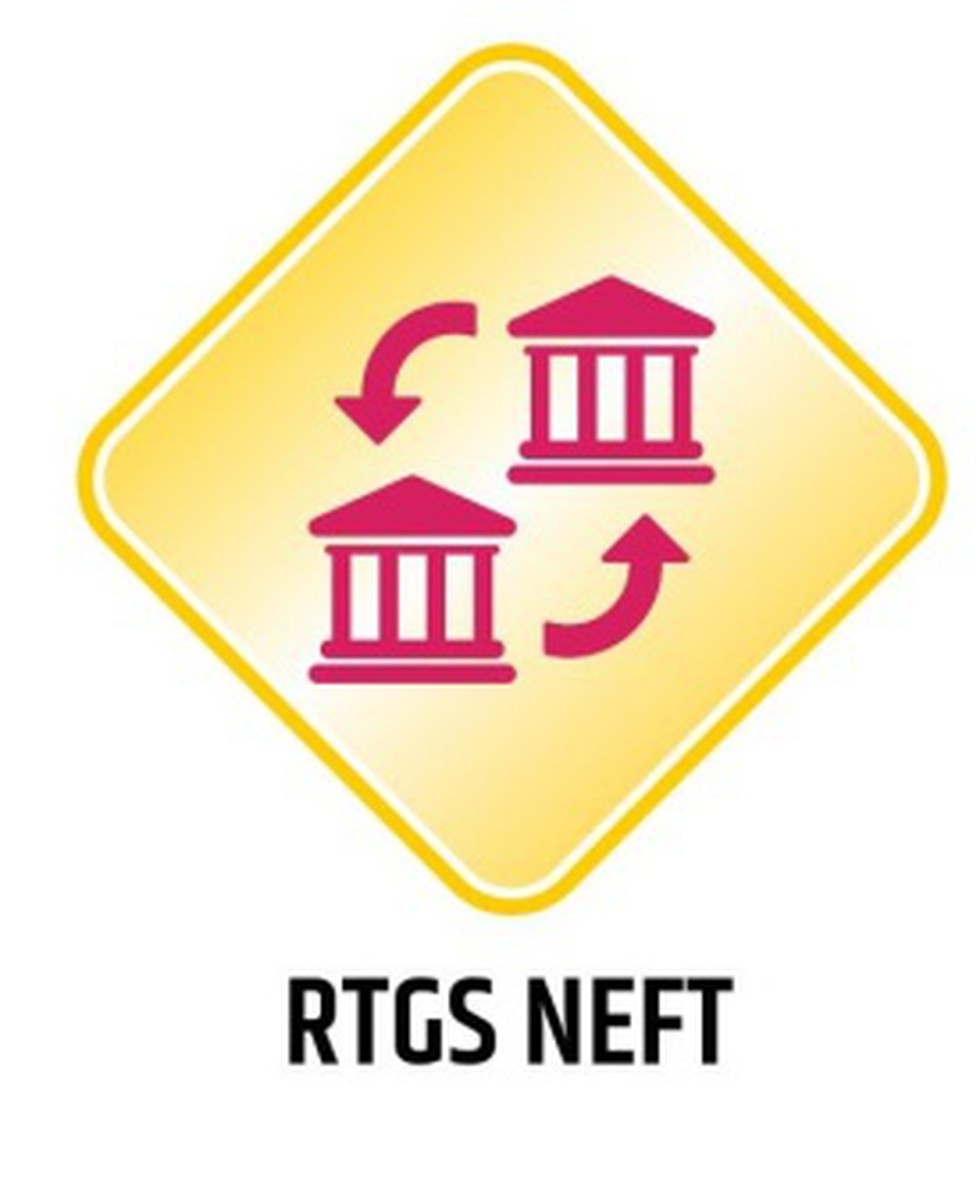
About NEFT:
- NEFT, which stands for National Electronic Funds Transfer, is an electronic method of transferring money online.
- Most Indian banks provide the NEFT feature on internet banking and mobile banking.
- It enables transferring funds from the account maintained with any bank to any other bank branch, provided the transaction is attempted between the banks that participate in the NEFT payment system.
- Transactions made through NEFT do not take place in real-time.
- As per Reserve Bank of India (RBI) guidelines, the payments made via NEFT are processed and settled half hourly batches.
- NEFT transactions can be performed 24*7.
- Minimum Transfer Value: Rs. 1
- Maximum transfer value: No limit
- Money transfer made through NEFT does not require any additional transaction costs.
About RTGS:
- RTGS, which stands for Real-time Gross Settlement, is a payment mode where the money is transferred from one bank account to the other in real-time, without any delay.
- It is mostly used for transactions of high value.
- When using the banking method, RTGS is the fastest possible way to transfer money.
- Transactions made through RTGS are processed on a one-to-one basis.
- RTGS transactions can be performed 24*7.
- Minimum Transfer Value: Rs. 2 lakh
- Maximum transfer value: No upper limit is there, but however can vary between banks.
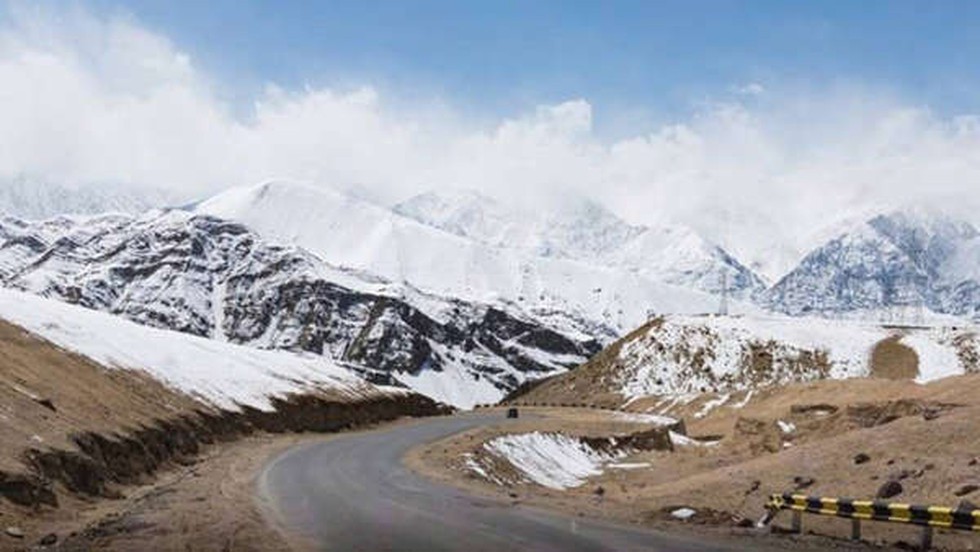
About Shinku La tunnel:
- It will be constructed at an altitude of over 16,500 feet on the Nimu-Padam-Darcha road link on the border between Ladakh and Himachal Pradesh.
- The length of the tunnel will be 4.1 km.
- The Border Roads Organization (BRO) will construct the tunnel at a cost of Rs. 1,681.5 crores.
- The traffic movement in the tunnel will not be vulnerable to long-range artillery shelling or missile firings either by China or Pakistan.
- Purpose:
- To provide all-weather connectivity to the border areas of Ladakh.
- To enable swift movement of troops and heavy weaponry to forward areas.
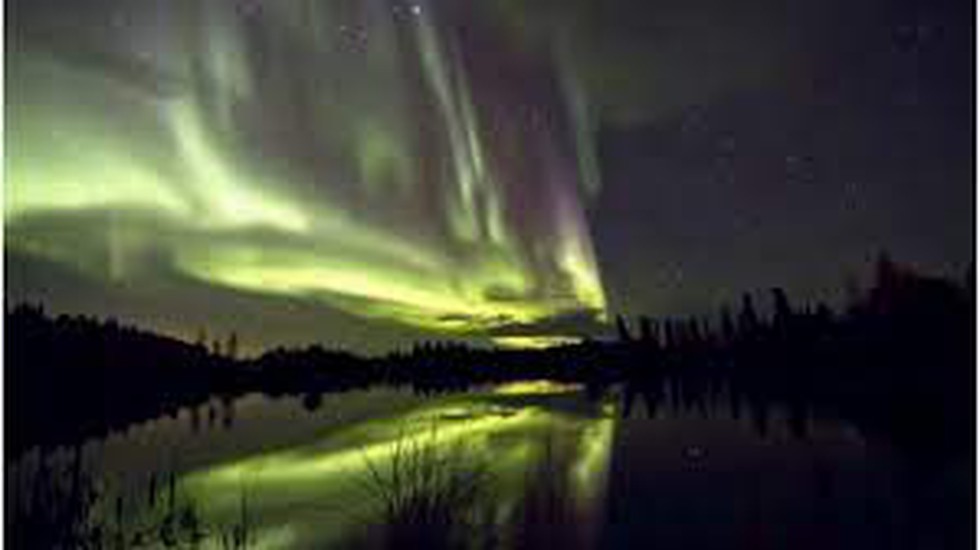
About Geomagnetic Storms:
- A geomagnetic storm is a major disturbance of Earth's magnetosphere.
- These storms result from variations in the solar wind that produces significant changes in the currents, plasmas, and fields in Earth’s magnetosphere.
- The solar wind conditions that are effective for creating geomagnetic storms are sustained (for several hours) periods of the high-speed solar wind and a southward-directed solar wind magnetic field (opposite the direction of Earth’s field) at the dayside of the magnetosphere.
- The largest such storms are associated with solar coronal mass ejections (CMEs), where a billion tons or so of plasma from the sun, with its embedded magnetic field, arrives at Earth.
- Effects:
- These storms can heat the ionosphere, causing beautiful auroras on Earth.
- Because the ionosphere is heated and distorted during storms, long-range radio communication that relies on sub-ionospheric reflection gets affected.
- Ionospheric expansion due to these storms can increase satellite drag and make their orbits difficult to control.
- Satellite electronics can be damaged through the build-up and discharge of static-electric charges.
- It can disrupt global navigation systems.
- It can create harmful geomagnetic-induced currents (GICs) in the power grid and pipelines.
What is a Solar wind?
- It is a stream of energized, charged particles, primarily electrons and protons, flowing outward from the Sun through the solar system at speeds as high as 900 km/s and a temperature of 1 million degrees (Celsius).
- It is made of plasma.
- When the solar wind reaches Earth, it sends a flurry of charged particles toward the magnetosphere, along Earth's magnetic field lines, towards the poles.
What are Coronal Mass Ejections (CMEs)?
- CMEs are large expulsions of plasma and magnetic field from the Sun’s corona that propagates outward into interplanetary space.
- The blast of a CME carries about a billion tons of material out from the Sun at very high speeds of hundreds of kilometers per second.

Key facts about Indian Pangolin:
- The Indian pangolin, also called thick-tailed pangolin and scaly anteater is native to the Indian subcontinent.
- It is one of the eight species of pangolins found.
- They are one of the most trafficked mammals in the world, despite an international ban on their trade.
- Scientific name: Manis crassicaudata
- Distribution: It lives in India (south of the Himalayas), Bangladesh, Southern Nepal, Sri Lanka, and small parts of Pakistan.
- Habitat: It occurs in tropical forests, open land, grasslands, and degraded habitat, including in close proximity to villages.
- Features:
- Like other pangolins, it has large, overlapping scales on its body, which act as armor.
- The Indian pangolin’s armor is amongst the most effective in the mammalian world. It has about 13 rows of moveable sharp scales covering its body, which are shed periodically.
- The colour of its scales varies depending on the colour of the earth in its surroundings.
- It can also curl itself into a ball as self-defense against predators.
- It is an insectivore feeding on ants and termites.
- It is nocturnal and rests in deep burrows during the day.
- Conservation status:
- IUCN Red List: Endangered
- Wildlife (Protection) Act, 1972: Schedule I
- CITES: Appendix I

About ‘Vayulink’ Platform:
- Vayulink is an ad-hoc data link communication system that would help pilots deal with bad weather and provide jammer-proof uninterrupted communication with the base station.
- It is developed by the Indian Air Force (IAF).
- It uses the Indian Regional Navigation Satellite System (IRNSS) to send radio communication to the base station when the signals are low.
- Vayulink, when installed in an aircraft, gives the position of other aircraft close by and encrypted traffic data over a secure channel.
- Uses:
- The platform helps to prevent fratricide or friendly fire, i.e., it helps us to know where the friendly forces are present.
- It provides better combat teaming.
- Helps plan real-time basis where multiple teams can get together and go towards the target coming from different areas.
- It can also give the pilots data on the weather.





























































































































































.png)
.png)
.png)
.png)
.png)


.png)
.png)
.png)





.png)
.png)






.png)
.png)
.png)
.png)
.png)
.png)
.png)
.png)
.png)

.png)







.png)
.png)


.png)
.png)
.png)


.png)

.png)
.png)





.jpg)

.png)
.png)


.png)

.png)
.png)
.png)

.jpg)

.jpg)


.png)

.png)
.png)
.png)
.png)
.png)
.png)
.png)
.png)
.png)
.png)




.png)

.png)





.png)
.png)
.png)
.png)
.png)
.png)
.png)
.png)
.png)
.png)
.jpg)
.jpg)

.png)
.png)
.png)
.png)
.png)
.png)
.png)
.png)
.png)
.png)
.png)
.png)
.png)
.png)
.png)
.png)
.png)
.png)
.png)
.png)
.png)
.png)



.png)
.png)

.jpg)
.jpg)


.jpg)
.jpg)
.jpg)
.jpg)
.jpg)

.jpg)








.jpg)
.jpg)
.jpg)
.jpg)
.jpg)

















.jpg)
.jpg)




.jpg)


















.jpg)
.jpg)






























































































.jpg)
.jpg)


























.jpg)

.jpg)










.jpg)








.jpg)




.jpg)










.jpg)


















.jpg)












































.jpg)














.jpg)
.jpg)
.jpg)





.jpg)

.jpg)
.jpg)





































































.jpg)


































.jpg)
.jpg)
















































.jpg)












.jpg)


.jpg)




.jpg)
.jpg)
.jpg)

.jpg)
.jpg)
.jpg)
.jpg)

.jpg)
.jpg)
.jpg)

.jpg)
.jpg)
.jpg)
.jpg)
.jpg)
.jpg)
.jpg)
.jpg)

.jpg)


.jpg)
.jpg)
.jpg)
.jpg)
.jpg)
.jpg)
.jpg)
.jpg)
.jpg)
.jpg)











.jpg)
.jpg)





.jpg)
.jpg)
.jpg)
























.jpg)
























.jpg)









.jpg)
.jpg)







.jpg)
.jpg)









































.jpg)
.jpg)
.jpg)
.jpg)
.jpg)

.jpg)
.jpg)
.jpg)
.jpg)
.jpg)


.jpg)
.jpg)
.jpg)
.jpg)
.jpg)

.jpg)
.jpg)
.jpg)
.jpg)
.jpg)
.jpg)
.jpg)
.jpg)
.jpg)
.jpg)
.png)

.png)
.png)

.png)
.png)
.png)
.png)


.jpg)
.jpg)

.jpg)
.jpg)
.jpg)

.png)
.png)
.png)
.png)
.png)
.png)
.png)

.png)
.png)
.png)
.png)
.png)
.png)
.png)
.png)
.png)
.png)





































































-min.png)



.png)




.png)








































